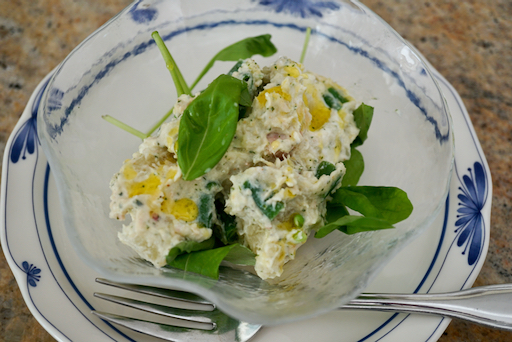We made pesto and froze it when we had a bumper crop of basil sometime ago. My wife found two small plastic containers in the freezer recently and tasked me to use it. I made two kinds of
garlic mozzarella bread, one with original garlic scallion butter and another with the pesto. The one with pesto was quite good. That left me with the 2-3 tbs of pesto. From the depth of my memory I remembered a recipe for potato salad with tuna and pesto from the “Frugal Gourmet*" cookbook. I sort of remembered how this was made but I decided I needed to find the recipe. After going through a number of his cookbooks which we have in our collection, I found the recipe in "
Frugal Gourmet cooks with wine". It was called "tuna and potato salad" which was introduced as an "American Italian" dish. In any case, I made this salad and finished up the pesto. It was definitely very distinctive and very good; quite different from my usual potato salad.
*When his show was popular on PBS in1980s, it was our routine to watch it on the weekend and we bought most of his cookbooks. Looking back, however, we think our cooking has advanced since then but at the time his recipes were quite inspirational.
I made a few modifications as usual.
Ingredients:
2 medium russet potatoes, boiled with skin on and then skin removed, cut (crumbed) into bite size chunks (original recipe calls for 6 small red potatoes).
One can of tuna in water, drained.
Blanched green beans, arbitrary amount (I prepared from fresh green beans, the original recipe calls for a 10 oz. package of frozen green beans, thawed, cooked and drained).
2 tbs pesto
3 tbs mayonnaise and 3 tbs Greek (strained) yogurt* (The original recipe calls for 1 cup mayo)
3 flat anchovies mashed (optional). I did not used them.
Salt and pepper to taste
3 tbs chopped parsley (I skipped this since I did not have fresh parsley)
Directions:
I seasoned the potatoes with salt, pepper and sushi vinegar while they were hot and I them cool in a bowl (my addition)
Cut the green beans in half inch length and add to the potato.
Add the pesto and tuna.
Add the mayo and Greek yogurt and mix.
Taste and season it with salt and pepper if needed.
This is a good salad to have. We really liked it.






















